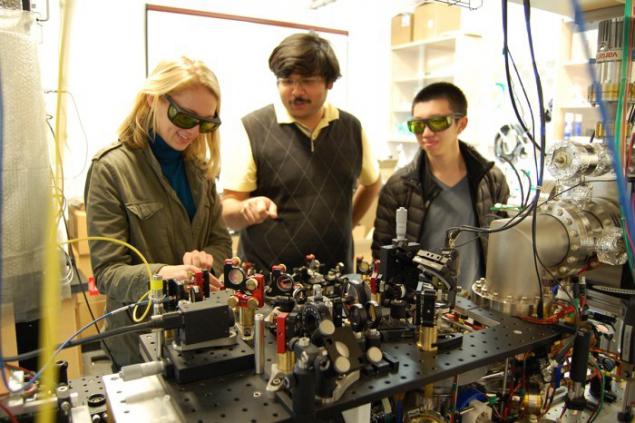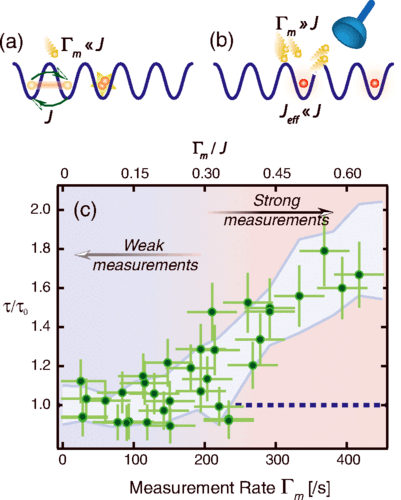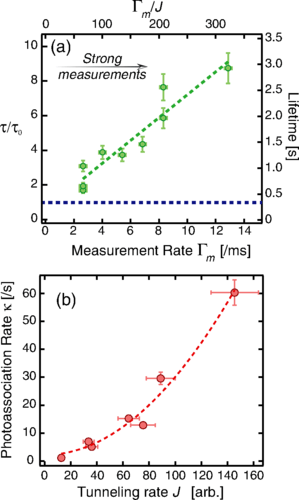Zeno effect confirmed: the atoms do not move, if you look at them
 Bashny.Net
Bashny.Net

Graduate students at Cornell University Yogesh Patil and Shrivatsan chakras and professor of physics in the laboratory Mukund Vengelattore Ultracold Lab i>
One of the strangest predictions of quantum theory - that the system can not be changed while you are watching it - подтверждён experiment at Cornell University (USA). The work opens the door to a fundamentally new ways of monitoring and control quantum states of atoms and may lead to new sensors.
The experiments were conducted in the laboratory of ultra-cold materials (Ultracold Lab) group led by physics professor Mukund Vengelattore (Mukund Vengalattore), who founded the first university program to study the properties of materials, chilled to 0, 000000001ºK. The results of the опубликованы October 2, 2015 in the journal Physical Review Letters.
Post-graduate students Yogesh Patil (Yogesh Patil) and Shrivatsan Chakras (Srivatsan Chakram) created and cooled a cloud of about a billion rubidium atoms inside a vacuum chamber between the intersecting laser beams. In this state, the atoms are arranged in an ordered lattice, like a solid crystal. At the same time at low temperatures manifested the effect of tunneling, when atoms are moved from one place to another in the lattice. The famous Heisenberg uncertainty principle says that the position and velocity of a particle bound and can not be precisely measured simultaneously. Temperature - is a measure of the particle velocity. In extreme conditions near absolute zero velocity of the particles is minimal, so they have a great variety of locations: if you look at them, the atoms can be in one place or another lattice.
Researchers have proven that they can suppress quantum tunneling by frequent observations of atoms квантовый Zeno effect , named after the Greek philosopher, first predicted in 1954 by Alan Turing, in 1978, American physicists Baydyanat Mizra and George Sudarshan described the effect named after him the ancient Greek philosopher Zeno of Elea. The name of the effect goes back to апории Zeno's arrow flight .
flying arrow is stationary, as in every moment of time it takes an equal position, that is at rest; because it rests in every moment, it is at rest at all times, ie there is no point in time at which the arrow is in motion. blockquote> This strange phenomenon is observed in the quantum world. Basically, a quantum system can be "frozen" by continuous repetitive observations.
Previous experiments have proved the existence of Zeno effect in the backs of subatomic particles, and this is the first demonstration of the effect at the atomic level.
Professor Vengelattore explained that during the experiment they are so good control over the grid of the atoms, they can not just freeze her condition, but also "customize" it to work by changing the parameters observing the atoms. This setting allows you to call the effect "arising classicism", when the atoms start to behave according to the ideas of classical physics. All quantum effects disappear.


The atoms were observed in the microscope laser illumination of the original development , which made atoms to fluoresce for ease of observation. In the absence of illumination atoms freely tunneled, and as soon as the laser was switched - tunneling sharply reduced. "It gives unprecedented control over the quantum system, perhaps even on individual atoms," - said Yogesh Patil, one of the authors of scientific work. Atoms in this state are extremely sensitive to external influences that can be used, for example, to develop a new generation of ultra-sensitive sensors.
Source: geektimes.ru/post/264598/
Tags
See also
Catalysts of change: Jennifer Dzheket about how shame will save the world
How much can change a man, if he has the desire, patience and will
A person can vary, but in one case only
A person can vary, but in one case only
10 of the most interesting psychological effects.
Make no mistake: The man can change only in one case
Get rid of the illusion that you can change other people
Woman his inner desire to change the world around them.
She showed how makeup can change beyond recognition
Prayers that can change your life



















